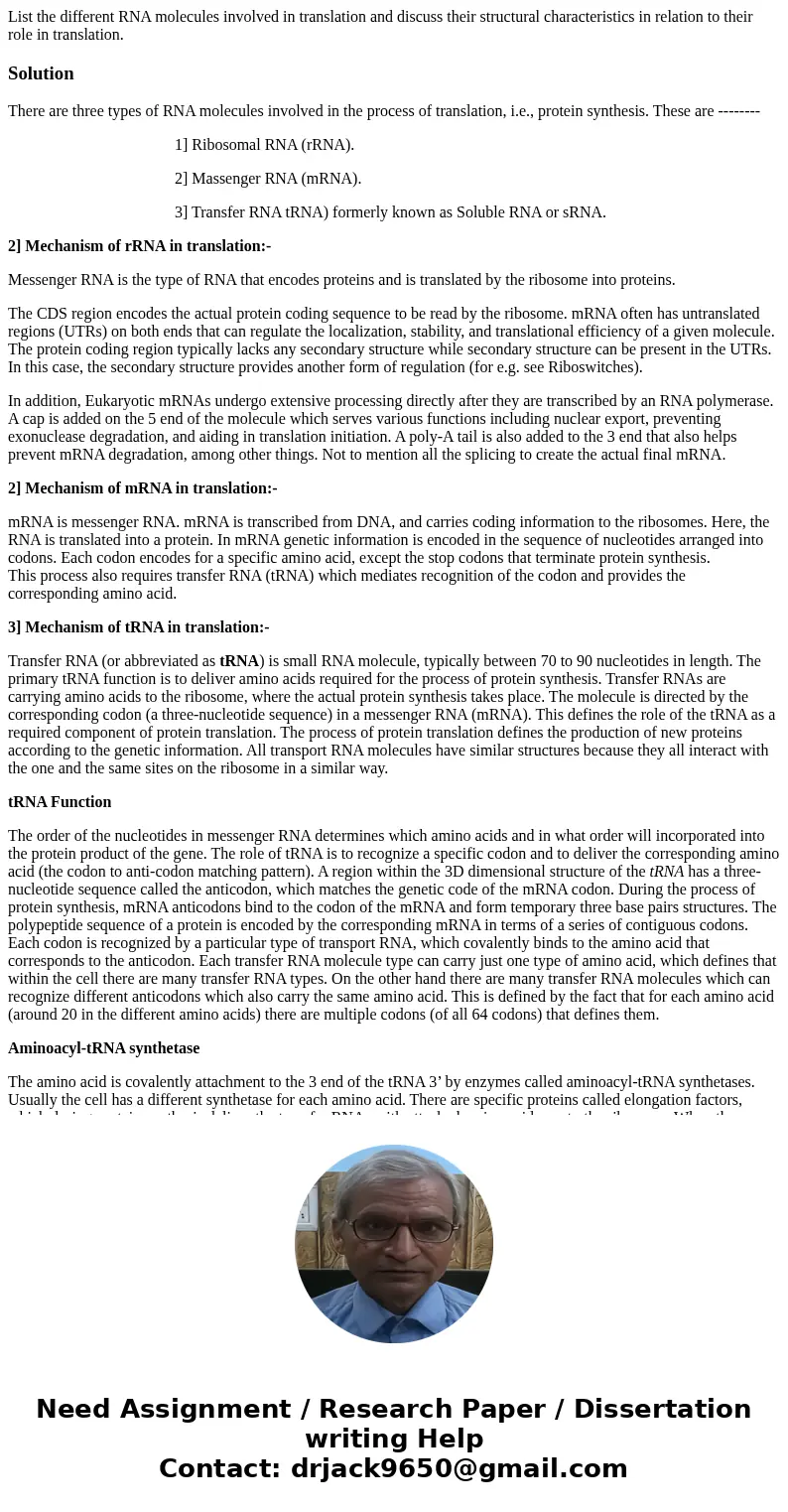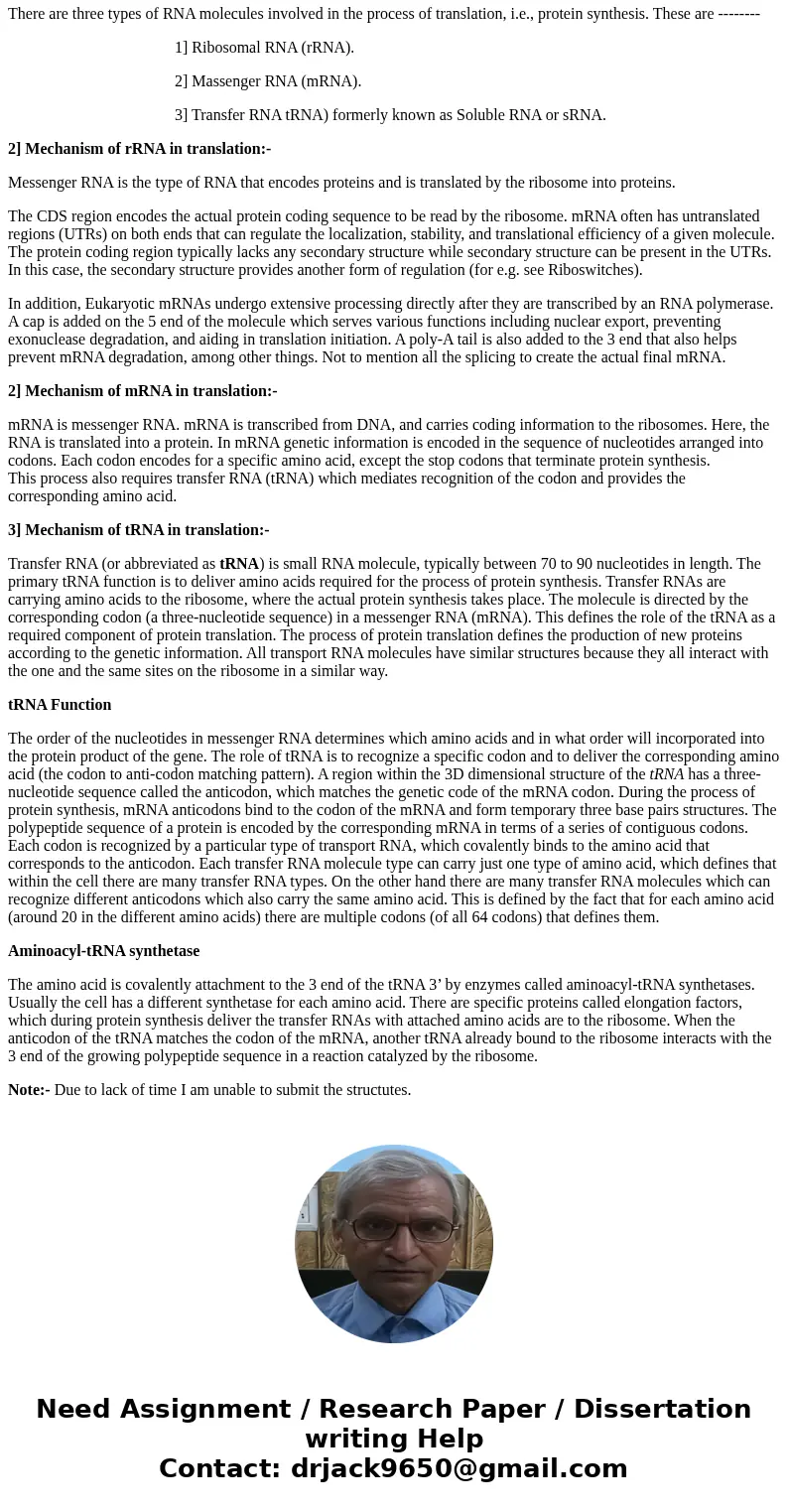List the different RNA molecules involved in translation and
List the different RNA molecules involved in translation and discuss their structural characteristics in relation to their role in translation.
Solution
There are three types of RNA molecules involved in the process of translation, i.e., protein synthesis. These are --------
1] Ribosomal RNA (rRNA).
2] Massenger RNA (mRNA).
3] Transfer RNA tRNA) formerly known as Soluble RNA or sRNA.
2] Mechanism of rRNA in translation:-
Messenger RNA is the type of RNA that encodes proteins and is translated by the ribosome into proteins.
The CDS region encodes the actual protein coding sequence to be read by the ribosome. mRNA often has untranslated regions (UTRs) on both ends that can regulate the localization, stability, and translational efficiency of a given molecule. The protein coding region typically lacks any secondary structure while secondary structure can be present in the UTRs. In this case, the secondary structure provides another form of regulation (for e.g. see Riboswitches).
In addition, Eukaryotic mRNAs undergo extensive processing directly after they are transcribed by an RNA polymerase. A cap is added on the 5 end of the molecule which serves various functions including nuclear export, preventing exonuclease degradation, and aiding in translation initiation. A poly-A tail is also added to the 3 end that also helps prevent mRNA degradation, among other things. Not to mention all the splicing to create the actual final mRNA.
2] Mechanism of mRNA in translation:-
mRNA is messenger RNA. mRNA is transcribed from DNA, and carries coding information to the ribosomes. Here, the RNA is translated into a protein. In mRNA genetic information is encoded in the sequence of nucleotides arranged into codons. Each codon encodes for a specific amino acid, except the stop codons that terminate protein synthesis.
This process also requires transfer RNA (tRNA) which mediates recognition of the codon and provides the corresponding amino acid.
3] Mechanism of tRNA in translation:-
Transfer RNA (or abbreviated as tRNA) is small RNA molecule, typically between 70 to 90 nucleotides in length. The primary tRNA function is to deliver amino acids required for the process of protein synthesis. Transfer RNAs are carrying amino acids to the ribosome, where the actual protein synthesis takes place. The molecule is directed by the corresponding codon (a three-nucleotide sequence) in a messenger RNA (mRNA). This defines the role of the tRNA as a required component of protein translation. The process of protein translation defines the production of new proteins according to the genetic information. All transport RNA molecules have similar structures because they all interact with the one and the same sites on the ribosome in a similar way.
tRNA Function
The order of the nucleotides in messenger RNA determines which amino acids and in what order will incorporated into the protein product of the gene. The role of tRNA is to recognize a specific codon and to deliver the corresponding amino acid (the codon to anti-codon matching pattern). A region within the 3D dimensional structure of the tRNA has a three-nucleotide sequence called the anticodon, which matches the genetic code of the mRNA codon. During the process of protein synthesis, mRNA anticodons bind to the codon of the mRNA and form temporary three base pairs structures. The polypeptide sequence of a protein is encoded by the corresponding mRNA in terms of a series of contiguous codons. Each codon is recognized by a particular type of transport RNA, which covalently binds to the amino acid that corresponds to the anticodon. Each transfer RNA molecule type can carry just one type of amino acid, which defines that within the cell there are many transfer RNA types. On the other hand there are many transfer RNA molecules which can recognize different anticodons which also carry the same amino acid. This is defined by the fact that for each amino acid (around 20 in the different amino acids) there are multiple codons (of all 64 codons) that defines them.
Aminoacyl-tRNA synthetase
The amino acid is covalently attachment to the 3 end of the tRNA 3’ by enzymes called aminoacyl-tRNA synthetases. Usually the cell has a different synthetase for each amino acid. There are specific proteins called elongation factors, which during protein synthesis deliver the transfer RNAs with attached amino acids are to the ribosome. When the anticodon of the tRNA matches the codon of the mRNA, another tRNA already bound to the ribosome interacts with the 3 end of the growing polypeptide sequence in a reaction catalyzed by the ribosome.
Note:- Due to lack of time I am unable to submit the structutes.


 Homework Sourse
Homework Sourse